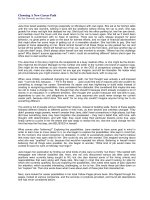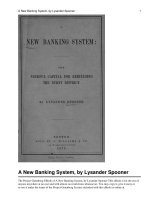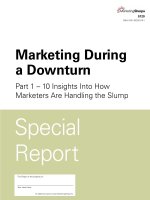All marketers are liars (with a new preface) ( PDFDrive com )
Bạn đang xem bản rút gọn của tài liệu. Xem và tải ngay bản đầy đủ của tài liệu tại đây (827.29 KB, 171 trang )
TableofContents
TitlePage
CopyrightPage
PREFACE
HIGHLIGHTS
GOTMARKETING?
STEP1:-THEIRWORLDVIEWANDFRAMESGOTTHEREBEFORE
YOUDID
STEP2:-PEOPLENOTICEONLYTHENEWANDTHENMAKEAGUESS
STEP3:-FIRSTIMPRESSIONSSTARTTHESTORY
STEP4:-GREATMARKETERSTELLSTORIESWEBELIEVE
EXAMPLES:STORIESFRAMEDAROUNDWORLDVIEWS
IMPORTANTASIDE:FIBSANDFRAUDS
STEP5:-MARKETERSWITHAUTHENTICITYTHRIVE
COMPETINGINTHELYINGWORLD
REMARKABLE?THECOWHASNOTLEFTTHEBUILDING
BONUSPART1:-MASTERSTORYTELLERSANDTHOSEWHOARE
STILLTRYING
BONUSPART2:-ADVANCEDRIFFS
GOODSTUFFTOREAD
SO,WHATTODONOW?
Acknowledgements
Dedication
INDEX
WHAT’SYOURSTORY?
PORTFOLIO
PublishedbythePenguinGroup
PenguinGroup(USA)Inc.,375HudsonStreet,
NewYork,NewYork10014,U.S.A.
PenguinGroup(Canada),90EglintonAvenueEast,Suite700,
Toronto,Ontario,CanadaM4P2Y3
(adivisionofPearsonPenguinCanadaInc.)
PenguinBooksLtd,80Strand,LondonWC2R0RL,England
PenguinIreland,25St.Stephen’sGreen,Dublin2,Ireland
(adivisionofPenguinBooksLtd)
PenguinBooksAustraliaLtd,250CamberwellRoad,Camberwell,
Victoria3124,Australia
(adivisionofPearsonAustraliaGroupPtyLtd)
PenguinBooksIndiaPvtLtd,11CommunityCentre,PanchsheelPark,
NewDelhi-110017,India
PenguinGroup(NZ),67ApolloDrive,Rosedale,NorthShore0632,
NewZealand(adivisionofPearsonNewZealandLtd)
PenguinBooks(SouthAfrica)(Pty)Ltd,24SturdeeAvenue,
Rosebank,Johannesburg2196,SouthAfrica
PenguinBooksLtd,RegisteredOffices:
80Strand,LondonWC2R0RL,England
Thiseditionpublishedin2009byPortfolio,
amemberofPenguinGroup(USA)Inc.
Copyright©DoYouZoom,Inc.,2005,2009
Allrightsreserved
PhotographreproducedbypermissionofTheLongabergerCompany.TheLongabergerCompany’sHome
Office
BuildinginNewark,Ohio,isatrademarkofTheLongabergerCompany.Copyright1997TheLongaberger
Company.
eISBN:978-1-10118454-7
Withoutlimitingtherightsundercopyrightreservedabove,nopartofthispublicationmaybereproduced,
storedinorintroducedintoaretrievalsystem,ortransmitted,inanyformorbyanymeans(electronic,
mechanical,photocopying,recordingorotherwise),withoutthepriorwrittenpermissionofboththe
copyrightownerandtheabovepublisherofthisbook.
Thescanning,uploading,anddistributionofthisbookviatheInternetorviaanyothermeanswithoutthe
permissionofthepublisherisillegalandpunishablebylaw.Pleasepurchaseonlyauthorizedelectronic
editionsanddonotparticipateinorencourageelectronicpiracyofcopyrightablematerials.Yoursupportof
theauthor’srightsisappreciated.
WhiletheauthorhasmadeeveryefforttoprovideaccuratetelephonenumbersandInternetaddressesatthe
timeofpublication,neitherthepublishernortheauthorassumesanyresponsibilityforerrors,orfor
changesthatoccurafterpublication.Further,publisherdoesnothaveanycontroloveranddoesnotassume
anyresponsibilityforauthororthird-partyWebsitesortheircontent.
Don’tjusttellmethefacts,
tellmeastoryinstead.
Beremarkable!
Beconsistent!
Beauthentic!
Tellyourstorytopeoplewhoareinclinedtobelieveit.
Marketingispowerful.Useitwisely.
Livethelie.
PREFACE
Youbelievethingsthataren’ttrue.
Letmesaythatadifferentway:Manythingsthataretruearetruebecauseyou
believethem.
The ideas in this book have elected a president, grown nonprofit causes,
createdbillionaires, andfueledmovements.They’vealsoledtogreatjobs, fun
dates,andmorethanafewinteractionsthatmattered.
I’ve seen this book in campaign headquarters and carried around at
evangelicalconferences.I’vealsogottene-mailfrompeoplewhohaveuseditin
JapanandtheUKandyes,Akron,Ohio.Theideashereworkbecausetheyare
simpletoolstounderstandwhathumanbeingsdowhentheyencounteryouand
yourorganization.
Here’s the first half of the simple summary: We believe what we want to
believe,andoncewebelievesomething,itbecomesaself-fulfillingtruth.(Jump
aheadafewparagraphstoreadthecriticalsecondpartofthissummary)
If you think that more expensive wine is better, then it is. If you think your
newbossisgoingtobemoreeffective,thenshewillbe.
Ifyoulovethewayacarhandles,thenyou’regoingtoenjoydrivingit.
That sounds so obvious, but if it is, why is it so ignored? Ignored by
marketers,ignoredbyordinarilyrationalconsumers,andignoredbyourleaders.
Once we move beyond the simple satisfaction of needs, we move into the
complex satisfaction of wants. And wants are hard to measure and difficult to
understand.Whichmakesmarketingthefascinatingexerciseitis.
Here’sthesecondpartofthesummary:Whenyouarebusytellingstoriesto
people who want to hear them, you’ll be tempted to tell stories that just don’t
holdup.Lies.Deceptions.
This sort of storytelling used to work pretty well. Joe McCarthy became
famous while lying about the “Communist threat.” Bottled water companies
made billions while lying about the purity of their product compared with tap
waterinthedevelopedworld.
The thing is, lying doesn’t pay off anymore. That’s because when you
fabricateastorythatjustdoesn’tholduptoscrutiny,yougetcaught.Fast.
So,it’stemptingtoputupademagogueforvicepresident,butitdoesn’ttake
long for the reality to catch up with the story. It’s tempting to spin a tall tale
aboutapieceoftechnologyoracustomerservicepolicy,butonceweseeitin
thewild,wetalkaboutitandyouwitheraway.
That’swhyIthinkthisbookisoneofthemostimportantI’vewritten.Ittalks
about two sides of a universal truth, one that has built every successful brand,
organization,andcandidate,andonethatwerarelyhavethewordstodescribe.
Here are the questions I hope you’ll ask (your boss, your colleagues, your
clients)afteryou’vereadthisbook:
“What’syourstory?”
“Willthepeoplewhoneedtohearthisstorybelieveit?”
“Isittrue?”
Everyday,weseemammothtechnologybrandsfailbecausetheyneglectedto
ask and answer these questions. We see worthy candidates gain little attention
andflawedonesbitethedust.Therearesmallbusinessesthataresofocusedon
whattheydothattheyforgettotakethetimetodescribethestoryofwhythey
doit.Andonandon.
Ifwhatyou’redoingmatters,reallymatters,thenIhopeyou’lltakethetimeto
tellastory.Astorythatresonatesandastorythatcanbecometrue.
The irony is that I did a lousy job of telling a story about this book. The
original jacket seemed to be about lying and seemed to imply that my readers
(marketers) were bad people. For people who bothered to read the book, they
couldseethatthiswasn’ttrue,butbythetimetheyopenedthebook,itwastoo
late.Astorywasalreadytold.
Ihadfailed.
Youdon’tgetasecondchanceinpublishingveryoften,andI’mthrilledthat
mypublisherletmetryanewjacket,andtriplythrilledthatitworked.Afterall,
you’rereadingthis.
So,gotellastory.Ifitdoesn’tresonate,telladifferentone.
Whenyoufindastorythatworks,livethatstory,makeittrue,authentic,and
subjecttoscrutiny.Allmarketersarestorytellers.Onlythelosersareliars.
HIGHLIGHTS
Ihavenointentionoftellingyouthetruth.
InsteadI’mgoingtotellyouastory.Thisisastoryaboutwhymarketersmust
forsake any attempt to communicate nothing but the facts, and must instead
focusonwhatpeoplebelieveandthenworktotellthemstoriesthataddtotheir
worldview.
Make no mistake. This is not about tactics or spin or little things that might
matter.Thisisawholenewwayofdoingbusiness.It’safundamentalshiftinthe
paradigmofhowideasspread.Eitheryou’regoingtotellstoriesthatspread,
oryouwillbecomeirrelevant.
In the first few pages, I’ll explain what the whole book is about, and then
we’ll take it apart, bit by bit, from the beginning, so you can learn how to tell
storiestoo.
INTHEBEGINNING,THEREWASTHESTORY
Before marketing, before shopping carts and long before infomercials, people
startedtellingthemselvesstories.
We noticed things. We noticed that the sun rose every morning and we
inventedastoryaboutHeliosandhischariot.Peoplegotsickandwemadeup
storiesabouthumorsandbloodlettingandwesentthemtothebarbertogetwell.
Stories make it easier to understand the world. Stories are the only way we
knowtospreadanidea.
Marketersdidn’tinventstorytelling.Theyjustperfectedit.
YOU’REALIAR
SoamI.
Everyone is a liar. We tell ourselves stories because we’re superstitious.
Storiesareshortcutsweusebecausewe’retoooverwhelmedbydatatodiscover
allthedetails.Thestorieswetellourselvesareliesthatmakeitfareasiertolive
inaverycomplicatedworld.Wetellstoriesaboutproducts,services,friends,job
seekers,theNewYorkYankeesandsometimeseventheweather.
Wetellourselvesstoriesthatcan’tpossiblybetrue,butbelievingthosestories
allowsustofunction.Weknowwe’renottellingourselvesthewholetruth,butit
works,soweembraceit.
Wetellstoriestoourspouses,ourfriends,ourbosses,ouremployeesandour
customers.Mostofall,wetellstoriestoourselves.
Marketers are a special kind of liar. Marketers lie to consumers because
consumers demand it. Marketers tell the stories, and consumers believe them.
Somemarketersdoitwell.Othersareprettybadatit.Sometimesthestorieshelp
peoplegetmoredone,enjoylifemoreandevenlivelonger.Othertimes,when
thestoryisn’tauthentic,itcanhavesignificantsideeffectsandconsumerspay
theprice.
Thereasonallsuccessfulmarketerstellstoriesisthatconsumersinsistonit.
Consumers are used to telling stories to themselves and telling stories to each
other, and it’s just natural to buy stuff from someone who’s telling us a story.
Peoplecan’thandlethetruth.
GEORGRIEDELISALIAR
Georgisatenth-generationglassblower,anartisanpursuinganage-oldcraft.I’m
toldhe’saveryniceguy.Andhe’sverygoodattellingstories.
His company makes wine glasses (and scotch glasses, whiskey glasses,
espressoglassesandevenwaterglasses).Heandhisstaffferventlybelievethat
thereisaperfect(anddifferent)shapeforeverybeverage.
According to Riedel’s Web site: “The delivery of a wine’s ‘message,’ its
bouquetandtaste,dependsontheformoftheglass.Itistheresponsibilityofa
glasstoconveythewine’smessagesinthebestmannertothehumansenses.”
Thomas Matthews, the executive editor of Wine Spectator magazine, said,
“EverybodywhoventuresintoaRiedeltastingstartsasaskeptic.Idid.”
The skepticism doesn’t last long. Robert Parker, Jr., the king of wine
reviewers, said, “The finest glasses for both technical and hedonistic purposes
arethosemadebyRiedel.Theeffectoftheseglassesonfinewineisprofound.I
cannotemphasizeenoughwhatadifferencetheymake.”
ParkerandMatthewsandhundredsofotherwineluminariesarenowbelievers
(and as a result, they are Riedel’s best word-of-mouth marketers). Millions of
winedrinkersaroundtheworldhavebeenpersuadedthata$200bottleofwine
(oracheapbottleofTwo-BuckChuck)tastesbetterwhenservedintheproper
Riedelglass.
TestsdoneinEuropeandtheUnitedStateshaveshownthatwineexpertshave
no trouble discovering just how much better wine tastes in the correct glass.
Presentedwiththesamewineinbothanordinarykitchenglassandtheproper
Riedelglass,theyrarelyfailtofindthattheexpensiveglassdeliversafarbetter
experience.
Thisisabreakthrough.A$5ora$20ora$500bottleofwinecanberadically
improvedbyusingarelativelyinexpensive(andreusable!)wineglass.
Andyetwhenthepropertestsaredonescientifically—double-blindteststhat
eliminateanychancethatthesubjectwouldknowtheshapeoftheglass—there
is absolutely zero detectible difference between glasses. A $1 glass and a $20
glassdeliverpreciselythesameimpactonthewine:none.
Sowhat’sgoingon?Whydowineexpertsinsistthatthewinetastesbetterina
Riedelglassatthesametimethatscientistscaneasilyproveitdoesn’t?Theflaw
intheexperiment,asoutlinedbyDanielZwerdlinginGourmetmagazine,isthat
the reason the wine tastes better is that people believe it should. This makes
sense,ofcourse.Tasteissubjective.IfyouthinkthepancakesattheIHOPtaste
better,thentheydo.Becauseyouwantthemto.
Riedelsellsmillionsofdollars’worthofglasseseveryyear.Hesellsglassesto
intelligent,well-offwineloverswhothenproceedtoenjoytheirwinemorethan
theydidbefore.
Marketing,apparently,makeswinetastebetter.Marketing,intheformofan
expensiveglassandthestorythatgoeswithit,hasmoreimpactonthetasteof
winethanoakcasksorfancycorksortheraininJune.GeorgRiedelmakesyour
winetastebetterbytellingyouastory.
SOMEOFMYBESTFRIENDSARELIARS
ArthurRioloisaworld-classstoryteller.Arthursellsrealestateinmylittletown
north of New York City. He sells a lot of real estate—more than all his
competitorscombined.That’sbecauseArthurdoesn’tsellanything.
Anyonecantellyouthespecsofahouseortalktoyouaboutthetaxes.Buthe
doesn’t. Instead, Arthur does something very different. He takes you and your
spouse for a drive. You drive up and down the hills of a neighborhood as he
pointsouthouseafterhouse(housesthataren’tforsale).Hetellsyouwholives
inthathouseandwhattheydoandhowtheyfoundthehouseandthenameof
theirdogandwhattheirkidsareuptoandhowmuchtheypaid.Hetellsyoua
story about the different issues in town, the long-simmering rivalries between
neighborhoods and the evolution and imminent demise of the Mother’s Club.
Then,andonlythen,doesArthurshowyouahouse.
ItmightbebecauseofArthur’santiquepickuptruckorthefactthateveryone
in town knows him or the obvious pleasure he gets from the community, but
soonerorlater,you’llbuyahousefromArthur.Andnotjustbecauseit’sagood
house.Becauseit’sagoodstory.
Bonnie Siegler and Emily Obermann tell stories too. They are graphic
designersinthetoughestmarketintheworld—NewYorkCity.Andtheyclaim
theirsuccessisaccidental.BonnieandEmilyrunNumber17,afirmwithclients
likeNBC,SexandtheCityandtheMercerHotel.
Everything about their firm, their site, their people, their office and their
personalities tells a story. It’s the same story; it’s consistent. It’s a story about
twoveryfunnyandcharismaticwomenwhodoiconoclasticworkthat’snotfor
everyone.TheirWebsiteisexactlyonepagelongandsomepeoplethinkithasa
typo on it. Their office is hidden behind a nondescript door in a nondescript
buildingonanoddballcornerofNewYork,butoncethedooropens,visitorsare
overwhelmedbyfun,nostalgia,quirkinessandrawenergy.
Nobody buys pure design from Number 17. They buy the way the process
makesthemfeel.
Sowhatdorealestate,graphicdesignandwineglasseshaveincommon?Not
alot.Notpricepointorfrequencyofpurchaseoradvertisingchannelsoreven
consumersales.Theonlythingtheyhaveincommonisthatnoonebuysfacts.
Theybuyastory.
WANTSANDNEEDS
Does it really matter that the $80,000 Porsche Cayenne and the $36,000 VW
Touaregarevirtuallythesamevehicle,madeinthesamefactory?Orthatyour
newlaptopisnotmeasurablyfasterinactualusethantheoneitreplaced?Why
do consumers pay extra for eggs marketed as being antibiotic free—when all
egg-layingchickensareraisedwithoutantibiotics,eventhekindofchickensthat
laycheapeggs?
The facts are irrelevant. In the short run, it doesn’t matter one bit whether
somethingisactuallybetterorfasterormoreefficient.Whatmattersiswhatthe
consumerbelieves.
Alongtimeago,therewasmoneytobemadeinsellingpeopleacommodity.
Makingyourproductorservicebetterandcheaperwasasurepathtogrowthand
profitability.Today,ofcourse,therulesaredifferent.Plentyofpeoplecanmake
something cheaper than you can, and offering a product or service that is
measurablybetterforthesamemoneyisahardedgetosustain.
Marketersprofitbecauseconsumersbuywhattheywant,notwhattheyneed.
Needs are practical and objective, wants are irrational and subjective. And no
matterwhatyousell—andwhetheryousellittobusinessesorconsumers—the
path to profitable growth is in satisfying wants, not needs. (Of course, your
productmustreallysatisfythosewants,notjustpretendto!)
CANPUMASREALLYCHANGEYOURLIFE?
In the coming pages, I will explain why people lie to themselves and how
necessarystoriesaretodealwiththedelugeofinformationallconsumersface
everyday.
Peoplebelievestoriesbecausetheyarecompelling.Welietoourselvesabout
what we’re about to buy. Consumers covet things that they believe will save
themtimeormakethemprettierorricher.Andconsumersknowtheirownhot
buttons better than any marketer can. So the consumer tells herself a story, an
involvedtalethatexplainshowthisnewpurchasewillsurelyanswerherdeepest
needs.
An hour ago, I watched a story transform the face of Stephanie, a physical
therapistwhoshouldknowbetter.Stephaniewasabouttobuyapairoflimited
editionsneakersfromPuma:$125forthepair,aboutwhatsheearns,aftertax,
afteralongdayofhardwork.
WasStephaniethinkingaboutsupportorsolematerialorthedurabilityofthe
uppers? Of course not. She was imagining how she’d look when she put them
on. She was visualizing her dramatically improved life once other people saw
how cool she was. She was embracing the idea that she was a grown-up, a
professionalwhocouldbuyaridiculouslypricedpairofsneakersifshewanted
to.Inotherwords,shewasbusylyingtoherself,tellingherselfastory.
ThewayStephaniefeltwhensheboughtthePumaswastheproduct.Notthe
sneakers(madefor$3inChina).Shecouldhaveboughtadequatefootwearfora
fractionofwhatthePumascost.Whatthemarketerssoldherwasastory,astory
thatmadeherfeelspecial.Stories(notideas,notfeatures,notbenefits)arewhat
spreadfrompersontoperson.
Makenomistake—thiswasnotanaccident.Pumaworkshardtotellastory.
It’sastoryabouthipnessandbelongingandfashion—andithasbuiltitsentire
businessaroundtheabilitytotellthisstory.
TELLINGAGREATSTORY
Trulygreatstoriessucceed becausethey areabletocapturetheimagination of
largeorimportantaudiences.
A great story is true. Not true because it’s factual, but true because it’s
consistentandauthentic.Consumersaretoogoodatsniffingoutinconsistencies
for a marketer to get away with a story that’s just slapped on. When the
LongabergerCorporationbuiltitsheadquarterstolooklikeagiantbasket,itwas
livingitsobsessionwiththeproduct—akeypartofitsstory.
Greatstoriesmakeapromise.Theypromisefunormoney,safetyorashortcut.
The promise is boldandaudaciousandnotjustverygood—it’sexceptional or
it’snotworthlisteningto.Phishoffereditslegionsoffansacompletelydifferent
concert experience. The promise of a transcendental evening of live music
allowedthegrouptoreachmillionsoflistenerswhoeasilyignoredthepablum
pouring out of their radios. Phish made a promise, and even better, kept that
promise.
Greatstoriesaretrusted.Trustisthescarcestresourcewe’vegotleft.Noone
trustsanyone.Consumersdon’ttrustthebeautifulwomenorderingvodkaatthe
cornerbar(they’regettingpaidbytheliquorcompany).Consumersdon’ttrust
thespokespeopleoncommercials(whoexactlyisRulaLenska?)andconsumers
don’ttrustthecompaniesthatmakepharmaceuticals(Vioxx,apparently,cankill
you).Asaresult,nomarketersucceedsintellingastoryunlesshehasearnedthe
credibilitytotellthatstory.
Greatstoriesaresubtle.Surprisingly,thelessamarketerspellsout,themore
powerfulthestorybecomes.Talentedmarketersunderstandthattheprospectis
ultimately telling himself the lie, so allowing him (and the rest of the target
audience)todrawhisownconclusionsisfarmoreeffectivethanjustannouncing
thepunchline.
Great stories happen fast. They engage the consumer the moment the story
clicks into place. First impressions are far more powerful than we give them
creditfor.Greatstoriesdon’talwaysneedeight-pagecolorbrochuresorafaceto-face meeting. Great stories match the voice the consumer’s worldview was
seeking, and they sync right up with her expectations. Either you are ready to
listentowhataPriusdeliversoryouaren’t.
Great stories don’t appeal to logic, but they often appeal to our senses.
Pheromonesaren’tamyth.Peopledecideiftheylikesomeoneafterjustasniff.
AndthedesignofanAlessiteapottalkstoconsumersinawaythatafactsheet
aboutboilingwaternevercould.
Great stories are rarely aimed at everyone. Average people are good at
ignoringyou.Averagepeoplehavetoomanydifferentpointsofviewaboutlife
and average people are by and large satisfied. If you need to water down your
story to appeal to everyone, it will appeal to no one. Runaway hits like the
LiveStrongfund-raisingbraceletstakeoffbecausetheymatchtheworldviewof
atinyaudience—andthenthattinyaudiencespreadsthestory.
Great stories don’t contradict themselves. If your restaurant is in the right
location but has the wrong menu, you lose. If your art gallery carries the right
artistsbutyourstaffisrejectsfromausedcarlot,youlose.Ifyoursubdivision
has lovely wooded groundsbutticky-tackyMcMansions,you lose.Consumers
arecleverandthey’llseethroughyourdeceitatonce.
Andmostofall,greatstoriesagreewithourworldview.Thebeststoriesdon’t
teachpeopleanythingnew.Instead,thebeststoriesagreewithwhattheaudience
alreadybelievesandmakesthemembersoftheaudiencefeelsmartandsecure
whenremindedhowrighttheywereinthefirstplace.
TELLINGASTORYBADLY:THEPLIGHTOFTHE
TELEMARKETER
It’s5:30.I’vegotthreepotsboilingonthestoveanddinnerisintwentyminutes.
Thephonerings.
AquickglanceatthecallerIDscreenshowsmeanumberandanareacode
that I’m not familiar with. The text ID says, “AAATeleServices.” I’m already
tellingmyselfastory.
The lie I’m telling myself isn’t pretty. It’s a detailed monologue about
someone trying to steal my time, to rip me off, to deal with me dishonestly. I
remindmyselfthatevenansweringthephoneputsmynumberonalistofnames
worthsellingtosomeoneelse.Still,Ichanceit.
“Hello?”
Mystoryisconfirmedinlessthanasecond.FirstIhearthetelltaleclickofa
dial-ahead computer-aided system passing me off to the next operator in line.
ThenIheartheuniquebustleandbackgroundnoiseofaboilerroomoperation.
Beforetheoperatorevenopenshismouth,thestoryispreviewed,toldandsold.
I’mnotinterested.
Forresearchpurposes,Ihangoninsteadofhangingup.
Theoperatorstartsgivingaprewrittenspeech.Hedoesn’tstopforatleastten
sentences.He’sreadingascriptandhe’snotdoingaparticularlygoodjobofit.
Thewordsdon’tmatchhisunsophisticatedtoneofvoice.
I’mlonggone,ofcourse.Butthefinalstrawiswhenhestartssayingthings
thatarepatentlyandtransparentlyuntrue.“I’mwiththeNewYorkStatePolice
Chief’sAssociationandwe’reraisingmoneyforthebenevolentfund.”
Is it any wonder that more than 50,000,000 people signed on to the Do Not
CallRegistryinjustamatterofweeks?Ifatelemarketerhasastorytotell,most
ofusdon’twanttohearit.
TELLINGASTORYWELL:KIEHL’SSINCE1851
About twenty years ago, long before online shopping, a colleague in Boston
askedmetostopbyKiehl’sSince1851,anobscuredrugstoreinManhattan.She
explainedthatithadaspecialskinlotionsheloved,andalwayseagertoplease,I
volunteeredtoheadafewblocksoutofmywayonedaytopicksomeup.
IwalkedintothestorenotknowingathingaboutKiehl’s,butcuriousabout
why someone would insist on a skin cream only available two hundred miles
awayfromhome.ThefirstthingIsawwhenIwalkedintothetinystorewasa
Ducatimotorcycleandatinystuntairplane.
NowIwasofficiallyintrigued.Whywasthisexpensiverealestatedevotedto
housingitemsthatclearlyhadnothingwhatsoevertodowithskincare?Therest
of the store was just as interesting. The rough-hewn floors were at least a
hundredyearsold.ThestaffwasfarbettertrainedthanI’deverexpectedtofind
in a drugstore. The labels were filled with information and each item was
lovinglydisplayed.
The message was loud and clear: this is the work of a person, a unique
individual,notacorporation.
Onlyapersonwouldwastesomuchspaceonhishobbies(andithadtobea
him,itseemedtome).Onlyapersonwouldbesopersnicketyabouttheformulas
andthelabelsandthemakingeverythingjustright.Inamarketplacefilledwith
anonymous competitors, this was the real deal—genuine cosmetics made by
someonewhocared.
The store was filled with other tidbits of information. Detailed narratives
aboutanimaltestingandmotorcycleracing,aboutthefoundersandabouttheir
customers.Thepriceswereridiculous,thebottlesunlikeanyI’deverseensold
formoney(theyappearedhomemade—andstilldo).Iboughtmycolleagueher
creamandheadedforhome,butnotbeforeI’dboughtmyselfsomeshavecream
andmywifeabarofsoap.Andjustlikealittlefamilybusiness,theyinsistedon
givingmesamplesofotherproductstotakehome—forfree.
Apparentlymanyothershavehadasimilarexperience.Kiehl’sSince1851is
now a cult brand. Sold by exclusive, service-oriented shops around the world,
thisbusinessisdoingmanymillionsofdollarsayearinhigh-marginsales.The
story is compelling. It’s easy to believe the lie we tell ourselves. So easy to
believethatmostofitscustomersareshockedwhentheydiscoverthatindustry
giantL’Oréalhasownedthecompanyforseveralyears.
Is the brand worth the premium they charge consumers? Well, if worth is
measured in the price charged compared to the cost of the raw ingredients, of
course not. But if Kiehl’s customers are measuring the price paid compared to
the experience of purchasing and the way that using the product makes them
feel,it’sano-brainer.
IsKiehl’sforeveryone?Notyet.Onlypeoplewithacertainworldvieweven
notice Kiehl’s, and then it takes a subset of that group to fall in love with the
story,totellitselfthelie.Thesepeopleembracethebrandandtellthestoryto
their friends as well. If a consumer believes that cosmetics should be cheap or
ubiquitousorthebrandthatabestfrienduses,thenKiehl’sisinvisible.Butifa
consumer’s worldview is about finding something offbeat, unique and
aggressivelyoriginal,thenthestoryresonates.
Ironically Kiehl’s didn’t set out to succeed by telling a unique story. This
brand is the work of an idiosyncratic individual, and lucky for him, his story
meshedwiththeworldviewofthepeoplewhoshoppedthere.Inotherwords,it
wasn’t Kiehl doing the marketing—it was his customers. Kiehl’s told a
story,andthecustomerstoldthelietothemselvesandtotheirfriends.
THEACCIDENTALMARKETER
Whomadegranolahealthy?
CertainlynottheGranolaManufacturersofAmerica,afictionalorganizationI
justdreamedup.NorwasitQuakerorAlpen.Thefactsofthecasearesimple:
mostgranolaisloadedwithsugarandsaturatedfats.It’snotgoodforyouatall.
But consumers decided it was a healthy, hippy, new-wave, nutritious, back-tonaturesnack,thesortofthingyoutookwithyouonhikesinthewoodsoratefor
breakfastataspa.
Sure,thebigmarketerscameinafterconsumersbelievedthestory,andthey
werequicktotakeadvantageofit.Theylaunchedallsortsofboxesandbrands
and ads—the expensive kind of marketing. But long before business school
tactics took over, the granola story established one thing with certainty:
consumers are complicit in marketing. Consumers believe stories. Without
thisbelief,thereisnomarketing.Amarketercanspendplentyonpromotinga
product, but unless consumers are actively engaged in believing the story,
nothinghappens.
MARKETERSAREN’TREALLYLIARS
Iwasn’tbeingcompletelytruthfulwithyouwhenInamedthisbook.Marketers
aren’t liars. They are just storytellers. It’s the consumers who are liars. As
consumers, we lie to ourselves every day. We lie to ourselves about what we
wear, where we live, how we vote and what we do at work. Successful
marketersarejusttheprovidersofstoriesthatconsumerschoosetobelieve.
Thisisabookaboutthepsychologyofsatisfaction.Ibelievethatpeopletell
themselves stories and then work hard to make them true. I call a story that a
consumerbelievesalie.Ithinkthatoncepeoplefindaremarkableliethatwill
benefit them if it spreads, they selfishly tell the lie to others, embellishing it
alongtheway.
Agoodstory(eitherfromthemarketerorfromthecustomerherself)iswhere
genuine customer satisfaction comes from. It’s the source of growth and profit
and it’s the future of your organization. Maybe who is lying to whom isn’t all
thatimportant,intheend,aslongastheconnectionhasbeenmadeandthestory
hasbeensuccessfullytold.
THISAPPEARSTOBEABOOKABOUTLYING
Buttheirony,ofcourse,isthatit’sabookabouttelling(andliving)thetruth.
The only way your story will be believed, the only way people will tell
themselvesthelieyouaredependingonandtheonlywayyourideawillspread
isifyoutellthetruth.Andyouaretellingthetruthwhenyoulivethestoryyou
aretelling—whenit’sauthentic.
The best stories marketers tell turn out to be true. Go to a product
development meeting at Nike or sit in on a recording session at Blue Note or
spendsometimewithPatRobertson—noneofthesemarketersaresittingaround
schemingupnewplansonhowtodeceivethepublic.Instead,theyarelivingand
breathing their stories. Not only are they lying to the public, they’re lying to
themselves.
This is what makes it all work:a complete dedication to and embrace of
yourstory.
ONELASTTHINGBEFOREWEGETGOING:KNOWYOUR
POWER
Ibelievemarketingisthemostpowerfulforceavailabletopeoplewhowant
tomake change. And with that power comes responsibility. We (anyone with
theabilitytotellastory—online,inprintortothepeopleinourcommunities)
havetheabilitytochangethingsmoredramaticallythaneverbeforeinhistory.
Marketershavetheleveragetogeneratehugeimpactinlesstime—andwithless
money—thaneverbefore.
There’s no question that consumers (and voters and nations, and so on) are
complicit in this storytelling process. No marketer can get a person to do
something without his active participation. But this complicity doesn’t absolve
marketersoftheresponsibilitythatcomeswiththeawesomepowerwe’vegotto
tellandspreadstories.
Thequestionyouhavetoaskyourselfisthis:whatareyougoingtodowith
thatpower?









